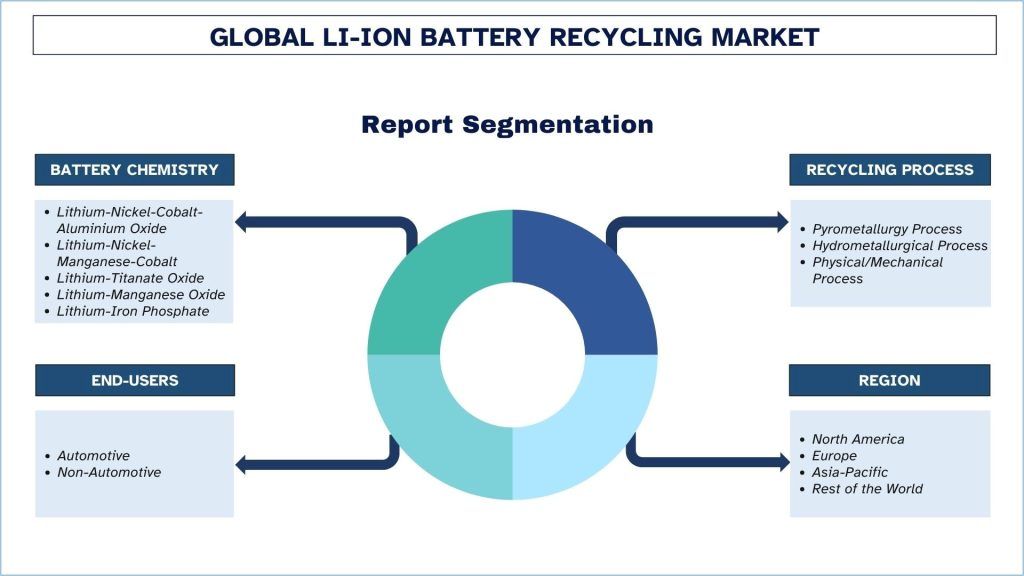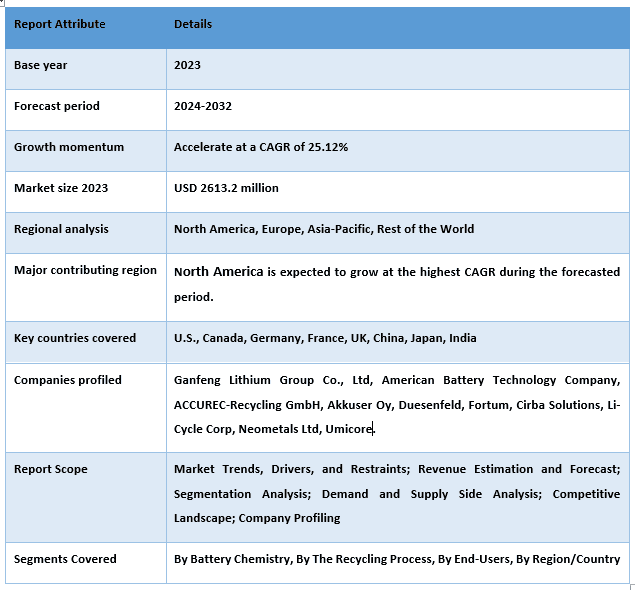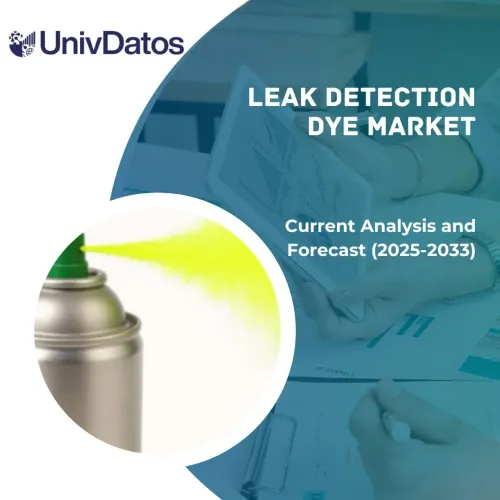- Home
- About Us
- Industry
- Services
- Reading
- Contact Us
Li-Ion Battery Recycling Market: Current Analysis and Forecast (2024-2032)
Emphasis on Battery Chemistry (Lithium-Nickel-Cobalt-Aluminum Oxide, Lithium-Nickel-Manganese-Cobalt, Lithium-Titanate Oxide, Lithium-Manganese Oxide, and Lithium-Iron-Phosphate); Recycling Process (Pyrometallurgy Process, Hydrometallurgical Process, And Physical/Mechanical Process); End-Users (Automotive and Non-Automotive); and Region/Country
Li-Ion Battery Recycling Market Size & Forecast
The Li-Ion Battery Recycling market was valued at approximately USD 2613.2 million in 2023 and is expected to grow at a substantial CAGR of around 25.12% during the forecast period (2024-2032) owing to the rapid rise in electric vehicle (EV) sales.
Li-Ion Battery Recycling Market Analysis
Li-Ion battery recycling is the concept of extracting valuable materials like lithium, cobalt, nickel, and other metals from no longer functioning or end-of-life lithium-ion batteries. They are widely applied in electric vehicles (EV), portable electronics energy storage devices, etc. Recycling reduces environmental impact by decreasing waste, curtailing resource consumption eliminating the requirement for extraction of raw materials, and favoring a circular economy as it recycles recovered materials to a new battery manufacturing.
Major companies are pushing the technological limits by incorporating advanced advances in hydrometallurgy, and direct recycling to increase the efficiency and reduce the environmental impact of the battery production process. For instance, in October 2023, RecycleKaro, a company specializing in lithium-ion battery recycling, entered a partnership with automotive manufacturer Bajaj Auto to address the recycling of lithium-ion batteries. Using its Hydrometallurgy technology, RecycleKaro plans to recycle batteries from Bajaj Auto vehicles, retrieving up to 95% of battery raw materials such as cobalt, lithium, nickel, and manganese. These materials can subsequently be used to produce new batteries. Additionally, major players are entering into strategic partnerships with EV manufacturers and energy companies to safeguard the supply chain and collection of utilized batteries. Also, growth is further driven by investment in R&D to optimize recycling processes, and government support by creating regulations and subsidies policies.

Li-Ion Battery Recycling Market Trends
This section discusses the key market trends influencing the various segments of the Li-Ion Battery Recycling market as identified by our research experts.
Partnerships with EV Manufacturers Transform the Li-Ion Battery Recycling Industry
The Li-ion battery recycling market is significantly shaped by partnerships with EV manufacturers, as they have been developing closed-loop systems for managing the battery’s lifecycle. These in turn guarantee a continuous supply of used batteries for recycling and decrease the refining of raw materials. EV manufacturers can align with the government rules of waste management and achieve their sustainability goals by working closely with recyclers. It’s also helping to bring those costs down associated with battery disposal and promoting the reuse of those valuable materials.
For instance, on September 23, 2024, US-based battery recycler Redwood Materials will recycle lithium-ion batteries from electric vehicles (EV) in automaking conglomerate BMW Group’s portfolio under a partnership with the group’s US subsidiary.
North America is expected to grow in the market
The Li-ion battery recycling market is led by North America, due to stringent government laws and incentives to reduce electronic waste and promote sustainable energy solutions in the region. Battery recycling programs are funded, amongst other things, by the U.S. Department of Energy to increase the recovery rate and efficiency of resources. Companies like ABTC and Li-Cycle are growing operationally with the help of collaborations with EV manufacturers to ensure a continual supply of used batteries. For instance, on May 30, 2024, Li-Cycle Partners with Daimler Truck North America on Recycling Lithium-ion Batteries. The goal is to integrate a comprehensive circular economy approach across its operations to reduce its carbon footprint. Moreover, recycled battery materials are gaining traction in the region due to the rising adoption of EV renewable energy storage. Also, technological progress in recycling methods contributes to the improvement of the recycling process efficiency and profitability.

Li-Ion Battery Recycling Industry Overview
The Li-Ion Battery Recycling market is competitive, with several global and international players. The key players are adopting different growth strategies to enhance their market presence, such as partnerships, agreements, collaborations, new product launches, geographical expansions, and mergers and acquisitions. Some of the major players operating in the market are Ganfeng Lithium Group Co., Ltd, American Battery Technology Company, ACCUREC-Recycling GmbH, Akkuser Oy, Duesenfeld, Fortum, Cirba Solutions, Li-Cycle Corp, Neometals Ltd, Umicore.
Li-Ion Battery Recycling Market News
In February 2024, Omega Seiki Private Ltd (OSPL) announced it had signed an agreement with Attero for the recycling of lithium-ion batteries. Under the collaboration, OSPL, along with e-waste management firm Attero, plans to recycle over 100MWh of batteries in the next 3-4 years, OSPL said in a statement.
In 2022 – Heritage Battery Recycling, an affiliate of Cirba Solutions, the largest and most comprehensive cross-chemistry battery management and materials processor in the industry, announced plans to construct a lithium-ion battery recycling facility in Eloy, Arizona.
Li-Ion Battery Recycling Market Report Coverage

Reasons to buy this report:
- The study includes market sizing and forecasting analysis validated by authenticated key industry experts.
- The report presents a quick review of overall industry performance at one glance.
- The report covers an in-depth analysis of prominent industry peers with a primary focus on key business financials, product portfolios, expansion strategies, and recent developments.
- Detailed examination of drivers, restraints, key trends, and opportunities prevailing in the industry.
- The study comprehensively covers the market across different segments.
- Deep dive regional level analysis of the industry.
Customization Options:
The global Li-Ion Battery Recycling market can be customized further as per the requirement or any other market segment. Besides this, UMI understands that you may have your own business needs, hence feel free to connect with us to get a report that completely suits your requirements.
Table of Content
Research Methodology for the Li-Ion Battery Recycling Market Analysis (2022-2032)
Analyzing the historical market, estimating the current market, and forecasting the future market of the global Li-Ion Battery Recycling market were the three major steps undertaken to create and analyze the adoption of Li-Ion Battery Recycling in major regions globally. Exhaustive secondary research was conducted to collect the historical market numbers and estimate the current market size. Secondly, to validate these insights, numerous findings and assumptions were taken into consideration. Moreover, exhaustive primary interviews were also conducted, with industry experts across the value chain of the global Li-Ion Battery Recycling market. Post assumption and validation of market numbers through primary interviews, we employed a top-down/bottom-up approach to forecasting the complete market size. Thereafter, market breakdown and data triangulation methods were adopted to estimate and analyze the market size of segments and sub-segments of the industry. Detailed methodology is explained below:
Analysis of Historical Market Size
Step 1: In-Depth Study of Secondary Sources:
A detailed secondary study was conducted to obtain the historical market size of the Li-Ion Battery Recycling market through company internal sources such as annual reports & financial statements, performance presentations, press releases, etc., and external sources including journals, news & articles, government publications, competitor publications, sector reports, third-party database, and other credible publications.
Step 2: Market Segmentation:
After obtaining the historical market size of the Li-Ion Battery Recycling market, we conducted a detailed secondary analysis to gather historical market insights and share for different segments & sub-segments for major regions. Major segments are included in the report as battery chemistry, recycling process, end-users, and regions. Further country-level analyses were conducted to evaluate the overall adoption of testing models in that region.
Step 3: Factor Analysis:
After acquiring the historical market size of different segments and sub-segments, we conducted a detailed factor analysis to estimate the current market size of the Li-Ion Battery Recycling market. Further, we conducted factor analysis using dependent and independent variables such as battery chemistry, recycling process, end-users, and regions of the Li-Ion Battery Recycling market. A thorough analysis was conducted for demand and supply-side scenarios considering top partnerships, mergers and acquisitions, business expansion, and product launches in the Li-Ion Battery Recycling market sector across the globe.
Current Market Size Estimate & Forecast
Current Market Sizing: Based on actionable insights from the above 3 steps, we arrived at the current market size, key players in the global Li-Ion Battery Recycling market, and market shares of the segments. All the required percentage shares split and market breakdowns were determined using the above-mentioned secondary approach and were verified through primary interviews.
Estimation & Forecasting: For market estimation and forecast, weights were assigned to different factors including drivers & trends, restraints, and opportunities available for the stakeholders. After analyzing these factors, relevant forecasting techniques i.e., the top-down/bottom-up approach were applied to arrive at the market forecast for 2032 for different segments and sub-segments across the major markets globally. The research methodology adopted to estimate the market size encompasses:
The industry’s market size, in terms of revenue (USD) and the adoption rate of the Li-Ion Battery Recycling market across the major markets domestically
All percentage shares, splits, and breakdowns of market segments and sub-segments
Key players in the global Li-Ion Battery Recycling market in terms of products offered. Also, the growth strategies adopted by these players to compete in the fast-growing market
Market Size and Share Validation
Primary Research: In-depth interviews were conducted with the Key Opinion Leaders (KOLs) including Top Level Executives (CXO/VPs, Sales Head, Marketing Head, Operational Head, Regional Head, Country Head, etc.) across major regions. Primary research findings were then summarized, and statistical analysis was performed to prove the stated hypothesis. Inputs from primary research were consolidated with secondary findings, hence turning information into actionable insights.
Split of Primary Participants in Different Regions

Market Engineering
The data triangulation technique was employed to complete the overall market estimation and to arrive at precise statistical numbers for each segment and sub-segment of the global Li-Ion Battery Recycling market. Data was split into several segments and sub-segments after studying various parameters and trends in the battery chemistry, recycling process, end-users, and regions of the global Li-Ion Battery Recycling market.
The main objective of the Global Li-Ion Battery Recycling Market Study
The current & future market trends of the global Li-Ion Battery Recycling market were pinpointed in the study. Investors can gain strategic insights to base their discretion for investments on the qualitative and quantitative analysis performed in the study. Current and future market trends determined the overall attractiveness of the market at a regional level, providing a platform for the industrial participant to exploit the untapped market to benefit from a first-mover advantage. Other quantitative goals of the studies include:
- Analyze the current and forecast market size of the Li-Ion Battery Recycling market in terms of value (USD). Also, analyze the current and forecast market size of different segments and sub-segments.
- Segments in the study include areas of the battery chemistry, recycling process, end-users, and regions.
- Define and analyze the regulatory framework for the Li-Ion Battery Recycling
- Analyze the value chain involved with the presence of various intermediaries, along with analyzing customer and competitor behaviors of the industry.
- Analyze the current and forecast market size of the Li-Ion Battery Recycling market for the major region.
- Major countries of regions studied in the report include Asia Pacific, Europe, North America, and the Rest of the World
- Company profiles of the Li-Ion Battery Recycling market and the growth strategies adopted by the market players to sustain the fast-growing market.
- Deep dive regional level analysis of the industry
Frequently Asked Questions FAQs
Q1: What is the Li-Ion Battery Recycling market's current size and growth potential?
Q2: What are the driving factors for the growth of the Li-Ion Battery Recycling market?
Q3: Which segment has the largest share of the Li-Ion Battery Recycling market by battery chemistry?
Q4: What are the major trends in the Li-Ion Battery Recycling market?
Q5: Which region will dominate the Li-Ion Battery Recycling market?
Related Reports
Customers who bought this item also bought











